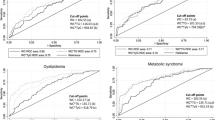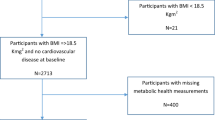Abstract
Background:
Some obese adults are not afflicted by the metabolic abnormalities often associated with obesity (the ‘metabolically healthy obese’ (MHO)); however, they may be at increased risk of developing cardiometabolic abnormalities in the future. Little is known about the relative incidence of individual components of metabolic syndrome (MetSyn).
Methods:
We used data from a multicenter, community-based cohort aged 45–64 years at recruitment (the Atherosclerosis Risk In Communities study) to examine the first appearance of any MetSyn component, excluding waist circumference. Body mass index (BMI, kg m−2) and cardiometabolic data were collected at four triennial visits. Our analysis included 3969 adults who were not underweight and free of the components of MetSyn at the initial visit. Participants were classified as metabolically healthy normal weight (MHNW), overweight (MHOW) and MHO at each visit. Adjusted hazard ratios (HR) and 95% confidence intervals were estimated with proportional hazards regression models.
Results:
The relative rate of developing each risk factor was higher among MHO than MHNW, with the strongest association noted for elevated fasting glucose (MHO vs MHNW, HR: 2.33 (1.77, 3.06)). MHO was also positively associated with elevated triglycerides (HR: 1.63 (1.27, 2.09)), low high-density lipoprotein-cholesterol (HR: 1.68 (1.32, 2.13)) and elevated blood pressure (HR: 1.54 (1.26, 1.88)). A similar, but less pronounced pattern was noted among the MHOW vs MHNW.
Conclusions:
We conclude that even among apparently healthy individuals, obesity and overweight are related to more rapid development of at least one cardiometabolic risk factor, and that elevations in blood glucose develop most rapidly.
This is a preview of subscription content, access via your institution
Access options
Subscribe to this journal
Receive 12 print issues and online access
$259.00 per year
only $21.58 per issue
Buy this article
- Purchase on Springer Link
- Instant access to full article PDF
Prices may be subject to local taxes which are calculated during checkout


Similar content being viewed by others
References
Calle EE, Kaaks R . Overweight, obesity and cancer: epidemiological evidence and proposed mechanisms. Nat Rev Cancer 2004; 4: 579–591.
Wildman RP, Muntner P, Reynolds K, McGinn AP, Rajpathak S, Wylie-Rosett J et al. The obese without cardiometabolic risk factor clustering and the normal weight with cardiometabolic risk factor clustering: prevalence and correlates of 2 phenotypes among the US population (NHANES 1999–2004). Arch Intern Med 2008; 168: 1617–1624.
Phillips CM . Metabolically healthy obesity: definitions, determinants and clinical implications. Rev Endocr Metab Disord 2013; 14: 219–227.
Meigs JB, Wilson PW, Fox CS, Vasan RS, Nathan DM, Sullivan LM et al. Body mass index, metabolic syndrome, and risk of type 2 diabetes or cardiovascular disease. J Clin Endocrinol Metab 2006; 91: 2906–2912.
Rhee EJ, Lee MK, Kim JD, Jeon WS, Bae JC, Park SE et al. Metabolic health is a more important determinant for diabetes development than simple obesity: a 4-year retrospective longitudinal study. PLoS One 2014; 9: e98369.
Kramer CK, Zinman B, Retnakaran R . Are metabolically healthy overweight and obesity benign conditions?: A systematic review and meta-analysis. Ann Intern Med 2013; 159: 758–769.
Bradshaw PT, Monda KL, Stevens J . Metabolic syndrome in healthy obese, overweight, and normal weight individuals: the Atherosclerosis Risk in Communities Study. Obesity (Silver Spring, MD) 2013; 21: 203–209.
Hwang LC, Bai CH, Sun CA, Chen CJ . Prevalence of metabolically healthy obesity and its impacts on incidences of hypertension, diabetes and the metabolic syndrome in Taiwan. Asia Pac J Clin Nutr 2012; 21: 227–233.
Achilike I, Hazuda HP, Fowler SP, Aung K, Lorenzo C . Predicting the development of the metabolically healthy obese phenotype. Int J Obes (Lond) 2015; 39: 228–234.
WHO Expert Consultation. Appropriate body-mass index for Asian populations and its implications for policy and intervention strategies. Lancet 2004; 363: 157–163.
Chang Y, Ryu S, Suh BS, Yun KE, Kim CW, Cho SI . Impact of BMI on the incidence of metabolic abnormalities in metabolically healthy men. Int J Obes (Lond) 2012; 36: 1187–1194.
Kang YM, Jung CH, Jang JE, Hwang JY, Kim EH, Park JY et al. The association of incident hypertension with metabolic health and obesity status: definition of metabolic health does not matter. Clin Endocrinol (Oxf) 2016; 85: 207–215.
Lee SK, Kim SH, Cho GY, Baik I, Lim HE, Park CG et al. Obesity phenotype and incident hypertension: a prospective community-based cohort study. J Hypertens 2013; 31: 145–151.
Jung CH, Lee MJ, Kang YM, Jang JE, Leem J, Hwang JY et al. The risk of incident type 2 diabetes in a Korean metabolically healthy obese population: the role of systemic inflammation. J Clin Endocrinol Metab 2015; 100: 934–941.
Heianza Y, Kato K, Kodama S, Suzuki A, Tanaka S, Hanyu O et al. Stability and changes in metabolically healthy overweight or obesity and risk of future diabetes: Niigata wellness study. Obesity (Silver Spring, MD) 2014; 22: 2420–2425.
Soriguer F, Gutierrez-Repiso C, Rubio-Martin E, Garcia-Fuentes E, Almaraz MC, Colomo N et al. Metabolically healthy but obese, a matter of time? Findings from the prospective Pizarra study. J Clin Endocrinol Metab 2013; 98: 2318–2325.
Navarro-Gonzalez D, Sanchez-Inigo L, Fernandez-Montero A, Pastrana-Delgado J, Alfredo Martinez J . Are all metabolically healthy individuals with obesity at the same risk of diabetes onset? Obesity (Silver Spring, MD) 2016; 24: 2615–2623.
Aung K, Lorenzo C, Hinojosa MA, Haffner SM . Risk of developing diabetes and cardiovascular disease in metabolically unhealthy normal-weight and metabolically healthy obese individuals. J Clin Endocrinol Metab 2014; 99: 462–468.
Hinnouho GM, Czernichow S, Dugravot A, Nabi H, Brunner EJ, Kivimaki M et al. Metabolically healthy obesity and the risk of cardiovascular disease and type 2 diabetes: the Whitehall II cohort study. Eur Heart J 2015; 36: 551–559.
Bell JA, Hamer M, Batty GD, Singh-Manoux A, Sabia S, Kivimaki M . Incidence of metabolic risk factors among healthy obese adults: 20-year follow-up. J Am Coll Cardiol 2015; 66: 871–873.
Appleton SL, Seaborn CJ, Visvanathan R, Hill CL, Gill TK, Taylor AW et al. Diabetes and cardiovascular disease outcomes in the metabolically healthy obese phenotype: a cohort study. Diabetes Care 2013; 36: 2388–2394.
Twig G, Afek A, Derazne E, Tzur D, Cukierman-Yaffe T, Gerstein HC et al. Diabetes risk among overweight and obese metabolically healthy young adults. Diabetes Care 2014; 37: 2989–2995.
The Atherosclerosis Risk in Communities (ARIC) Study: design and objectives. The ARIC investigators. Am J Epidemiol 1989; 129: 687–702.
Willett WC, Sampson L, Stampfer MJ, Rosner B, Bain C, Witschi J et al. Reproducibility and validity of a semiquantitative food frequency questionnaire. Am J Epidemiol 1985; 122: 51–65.
Baecke JA, Burema J, Frijters JE . A short questionnaire for the measurement of habitual physical activity in epidemiological studies. Am J Clin Nutr 1982; 36: 936–942.
Grundy SM, Brewer Jr HB, Cleeman JI, Smith Jr SC, Lenfant C . Definition of metabolic syndrome: Report of the National Heart, Lung, and Blood Institute/American Heart Association conference on scientific issues related to definition. Circulation 2004; 109: 433–438.
Lindsey JC, Ryan LM . Tutorial in biostatistics methods for interval-censored data. Stat Med 1998; 17: 219–238.
Amorim LD, Cai J . Modelling recurrent events: a tutorial for analysis in epidemiology. Int J Epidemiol 2015; 44: 324–333.
Witte JS, Greenland S . A nested approach to evaluating dose-response and trend. Ann Epidemiol 1997; 7: 188–193.
Stevens J, Truesdale KP, Wang CH, Cai J, Erber E . Body mass index at age 25 and all-cause mortality in whites and African Americans: the Atherosclerosis Risk in Communities study. J Adolesc Health 2012; 50: 221–227.
Therneau TM, Grambsh PM . Modeling Survival Data: Extending the Cox model. Springer: New York, NY, USA, 2000.
Therneau TM . A Package for Survival Analysis in S. 2.38 edn. Available at: https://cran.r-project.org/package=survival 2015.
R Core Team . R. A Language and Environment for Statistical Computing, 3.3.1 edn. R Foundation for Statistical Computing: Vienna, Austria, 2016.
Katzmarzyk PT, Bray GA, Greenway FL, Johnson WD, Newton Jr RL, Ravussin E et al. Racial differences in abdominal depot-specific adiposity in white and African American adults. Am J Clin Nutr 2010; 91: 7–15.
Camhi SM, Bray GA, Bouchard C, Greenway FL, Johnson WD, Newton RL et al. The relationship of waist circumference and BMI to visceral, subcutaneous, and total body fat: sex and race differences. Obesity (Silver Spring, MD) 2011; 19: 402–408.
Katzmarzyk PT, Heymsfield SB, Bouchard C . Clinical utility of visceral adipose tissue for the identification of cardiometabolic risk in white and African American adults. Am J Clin Nutr 2013; 97: 480–486.
Bradshaw PT, Stevens J . Invited commentary: limitations and usefulness of the metabolically healthy obesity phenotype. Am J Epidemiol 2015; 182: 742–744.
Karelis AD, Brochu M, Rabasa-Lhoret R . Can we identify metabolically healthy but obese individuals (MHO)? Diabetes Metab 2004; 30: 569–572.
Rey-Lopez JP, de Rezende LF, Pastor-Valero M, Tess sBH . The prevalence of metabolically healthy obesity: a systematic review and critical evaluation of the definitions used. Obes Rev 2014; 15: 781–790.
Primeau V, Coderre L, Karelis AD, Brochu M, Lavoie ME, Messier V et al. Characterizing the profile of obese patients who are metabolically healthy. Int J Obes (Lond) 2011; 35: 971–981.
Reaven GM . Banting lecture 1988. Role of insulin resistance in human disease. Diabetes 1988 37: 1595–1607.
Karelis AD, Rabasa-Lhoret R . Inclusion of C-reactive protein in the identification of metabolically healthy but obese (MHO) individuals. Diabetes Metab 2008; 34: 183–184.
Karelis AD, Faraj M, Bastard JP, St-Pierre DH, Brochu M, Prud'homme D et al. The metabolically healthy but obese individual presents a favorable inflammation profile. J Clin Endocrinol Metab 2005; 90: 4145–4150.
Acknowledgements
The Atherosclerosis Risk in Communities Study is carried out as a collaborative study supported by National Heart, Lung and Blood Institute contracts (HHSN268201100005C, HHSN268201100006C, HHSN268201100007C, HHSN268201100008C, HHSN268201100009C, HHSN268201100010C, HHSN268201100011C, and HHSN268201100012C). We thank the staff and participants of the ARIC study for their important contributions.
Author information
Authors and Affiliations
Corresponding author
Ethics declarations
Competing interests
The authors declare no conflict of interest.
Rights and permissions
About this article
Cite this article
Bradshaw, P., Reynolds, K., Wagenknecht, L. et al. Incidence of components of metabolic syndrome in the metabolically healthy obese over 9 years follow-up: the Atherosclerosis Risk In Communities study. Int J Obes 42, 295–301 (2018). https://doi.org/10.1038/ijo.2017.249
Received:
Revised:
Accepted:
Published:
Issue Date:
DOI: https://doi.org/10.1038/ijo.2017.249
This article is cited by
-
Obesity phenotypes and cardiovascular risk: From pathophysiology to clinical management
Reviews in Endocrine and Metabolic Disorders (2023)
-
Metabolically healthy obesity is associated with longitudinal changes in high-density lipoprotein cholesterol in Chinese adults
Eating and Weight Disorders - Studies on Anorexia, Bulimia and Obesity (2021)
-
Both sedentary time and physical activity are associated with cardiometabolic health in overweight adults in a 1 month accelerometer measurement
Scientific Reports (2020)
-
Metabolically Healthy Obesity and Bariatric Surgery
Obesity Surgery (2019)
-
Editors’ note: Omitting obesity treatment leads to poor outcomes, even in those who appear to be metabolically healthy
International Journal of Obesity (2018)



